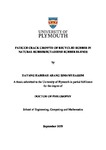FATIGUE CRACK GROWTH OF RECYCLED RUBBER IN NATURAL RUBBER/BUTADIENE RUBBER BLENDS
| dc.contributor.supervisor | Abraham, Frank | |
| dc.contributor.author | Binti Abang Ismawi Hassim, Dayang Habibah | |
| dc.contributor.other | School of Engineering, Computing and Mathematics | en_US |
| dc.date.accessioned | 2019-09-09T15:58:58Z | |
| dc.date.issued | 2019 | |
| dc.identifier | 10511175 | en_US |
| dc.identifier.uri | http://hdl.handle.net/10026.1/14902 | |
| dc.description.abstract |
Ground rubber from waste tyres may be added to elastomers to provide economic and environmental benefits. Both untreated and treated fillers have been investigated in different types of virgin rubber matrix. A principal concern is their crosslinked structure and large particle sizes. These additional fillers introduce flaws corresponding to micro-crack initiation sites especially under dynamic loading. Smaller particles, incorporated at a suitable concentration, may alleviate reduction of key mechanical properties. Many studies involving recycled rubber powder (RRP), untreated or treated materials, focus mainly on the quasi-static mechanical properties; generally few works examine the fatigue life and fracture morphology. In this study, two different RRPs: (i) crumb rubber powder (denoted as CRP400 ~400 µm nominal diameter) and (ii) micronised rubber powder (denoted as MRP074 ~74 µm nominal diameter), from ambient and cryogenic production respectively, were characterised. The effect of RRP on the cure characteristics, mechanical properties (tensile strength, crescent tear, and abrasion resistance) and fatigue crack growth (FCG) were studied in Natural Rubber (NR)/Butadiene Rubber (BR) blends. This study includes a filler-matrix interface study using ‘network visualisation’ via transmission electron microscopy of the unfilled NR or BR matrix (without carbon black filler). Lorenz-Park, Cunnen and Russel, and Kraus equations based on an equilibrium swelling study were used to investigate the extent of interaction between RRP and rubber matrix. The study provides understanding of the adhesion between filler-rubber matrices, which partially contributed to the crescent tear strength. For fatigue crack growth performance, the energy balance approach for the crack growth analysis could provide a better approach for RRP evaluation. Determination of absolute and relative hysteresis loss during FCG testing was conducted under constant displacement amplitudes, while compensating for permanent set throughout the fatigue cycles. Different trends in relative hysteresis loss suggest that an additional energy dissipation mechanism due to multiple new crack surfaces at the crack tip contributes to the FCG of the RRP. Higher absolute and relative hysteresis loss, at higher tearing energy, are slightly detrimental to the crack growth rates of the RRP compounds. Fracture morphologies at different tearing energies for NR/BR and RRP filled compound were discussed. Differences in the surface fracture topography at various tearing energies revealed the dependency of the crack growth microstructure on the tearing energies. The different rankings were displayed for MRP074 or CRP400 filler using conventional rubber test standards and fracture mechanics. Although the average CRP400 particle diameter is approximately a factor of five larger than that of MRP074, the CRP400 compound exhibits a lower crack growth rate in the technically important low strains/tearing energies region. The “rougher”/irregular surface of CRP400 appears to be a more important factor than the particle size of MRP074 for the FCG performance, especially at lower strains. The findings offer a different approach in evaluating RRP for application in the elastomeric matrix. | en_US |
| dc.description.sponsorship | Malaysian Rubber Board | en_US |
| dc.language.iso | en | |
| dc.publisher | University of Plymouth | |
| dc.rights | Attribution-NonCommercial-NoDerivs 3.0 United States | * |
| dc.rights.uri | http://creativecommons.org/licenses/by-nc-nd/3.0/us/ | * |
| dc.subject | Recycled rubber powder | en_US |
| dc.subject | Fatigue crack growth | en_US |
| dc.subject | Elastomer | en_US |
| dc.subject | Waste tyres | en_US |
| dc.subject.classification | PhD | en_US |
| dc.title | FATIGUE CRACK GROWTH OF RECYCLED RUBBER IN NATURAL RUBBER/BUTADIENE RUBBER BLENDS | en_US |
| dc.type | Thesis | |
| plymouth.version | publishable | en_US |
| dc.identifier.doi | http://dx.doi.org/10.24382/1017 | |
| dc.rights.embargodate | 2020-09-09T15:58:58Z | |
| dc.rights.embargoperiod | 12 months | en_US |
| dc.type.qualification | Doctorate | en_US |
| rioxxterms.version | NA | |
| plymouth.orcid_id | https://orcid.org/0000-0002-6620-7237 | en_US |
Files in this item
This item appears in the following Collection(s)
-
01 Research Theses Main Collection
Research Theses Main



